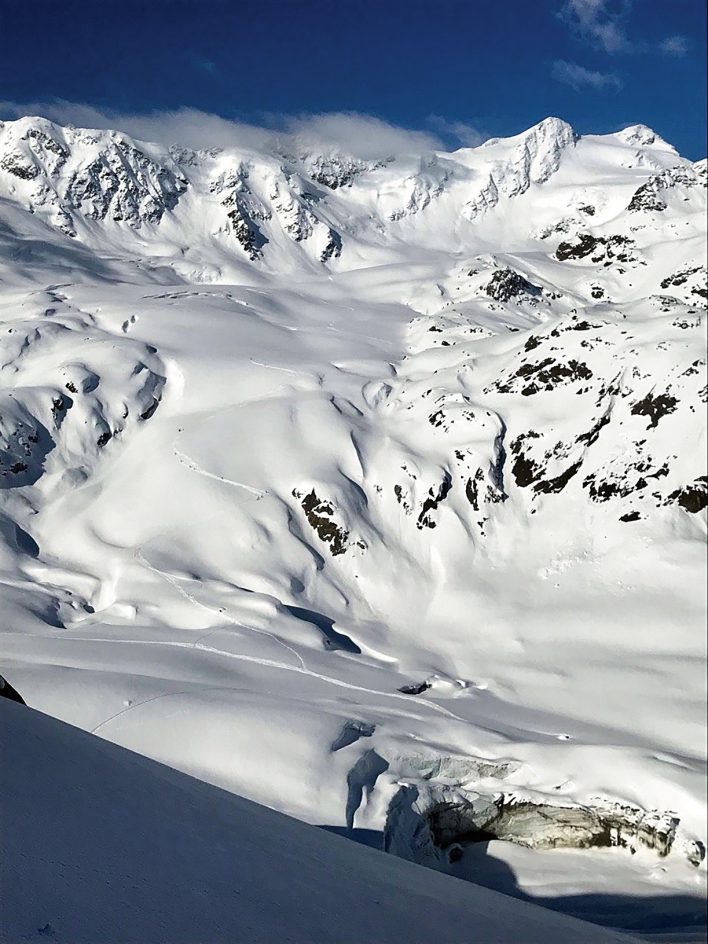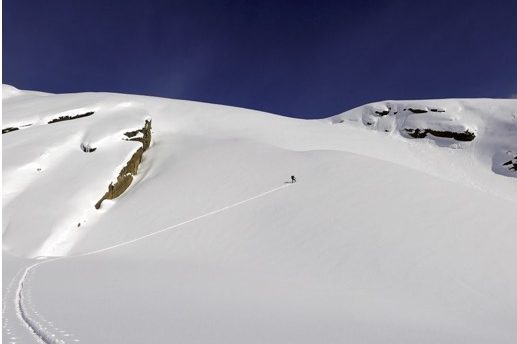I hate terrible skintracks. Following a steep, brutal route only to find an icy corner above a tree well brings me zero joy. My inflexible hips scream when the skinner incessantly kickturns back and forth. Setting good skintracks is ultimately a personal pursuit, but when others are following, it becomes a community issue. So, what’s the best way to travel?

Consistency is Key
To Alex Geary, internationally certified ski guide and author of The Art of Up-tracking, the ideal skintrack is a model of consistency. “I try to have a good flow with the skintrack,” he says, “and having a consistent grade helps with that.” In his book, which details everything from skintrack setting and routefinding to crossing glaciers and navigating flat light, Geary writes that he doesn’t ascribe to a perfect grade.
Instead, he finds a pitch comfortable enough to move efficiently and deal with obstacles like seracs or crevasses. “If you start slipping, need to lean on your poles, or excessively engage your core, the track is probably too steep,” he writes.
“You’re balancing efficiency and safety,” he tells me. In practical terms, that means using the terrain presented to you to find the shortest route that isn’t too steep. When approaching a knoll, for example, Geary suggests contouring around it gently, rather than going up and over it. If you’re traveling in terrain with seracs and cornices, your track might be longer to skirt the overhead danger.
Kick and Twist
Anyone who’s ever struggled to set a kickturn in deep snow recognizes the energy it requires. In most terrain, avoiding hard corners is the efficient course. Using microridges and knolls to guide swooping turns, rather than severe ones, both uses the slope to conserve energy and creates a track that’s easy to follow. Still, kickturns are an unavoidable part of touring. Kylee Toth, skimo athlete and coach at Evoke Endurance, says, “Sometimes, if you’re very good at kickturns, it’s more efficient to throw them in.” To get better at them, Toth says to practice by ascending a short slope and doing as many kickturns as possible.
The last resort in setting a track is bootpacking. Geary reserves it for when skinning becomes too difficult or inefficient, such as cutting kickturns every few steps in a couloir. He also suggested utilizing the bootpack to avoid pockets of wind slab, especially in steep terrain, though he ultimately concluded, “The vast majority of the time I try and avoid bootpacking whenever I can.”
Pace Perfection
It’s all well and good to imagine that perfect, gently sloping, kickturn-free skintrack, but if you blow up and bonk before reaching your objective, how well you placed your corners won’t matter. Especially on long days, pacing is paramount. Like a freshman on the cross-country team, if you push too hard too early, you’ll find yourself slowing at the end, potentially putting yourself at risk by crossing dangerous terrain later in the day.
“You should probably be doing a long day in your aerobic zone,” Toth says, referring to a pace you can sustain for hours. Heart rate or lactate tests can conclusively define one’s aerobic zone, but Toth says there’s a less-scientific way of determining it: “You should be able to carry on a conversation. It can be a little bit labored, but if you can’t talk, you’re going too hard.”
Like Geary, Toth espouses efficiency, though in addition to setting good tracks, she uses it to refer to the way skiers move. Improving preseason aerobic fitness can increase the speed at which you can move in your aerobic zone, meaning faster touring. Bolstering leg muscles through strength training can also increase physical efficiency, Toth says, because “you’re essentially doing thousands of little squats throughout your day.”

On the skintrack itself, she says tourers should focus on their strides. Many skiers, for the sake of setting a fast pace, take long steps, but bigger strides can lead to fatigue and poor skintrack shape, as they limit your ability to feel the terrain with your legs. Shorter steps will help you slide your feet, as opposed to lifting them, an action guaranteed to tire out your legs.
Gear plays a role in efficiency, Toth says, starting with weight. Lighter gear will be less taxing, so she suggests that as you buy new pieces of gear, think about shaving a few grams with each purchase. One small change that won’t cost as much as a pair of carbon skis is your skins. “In terms of the efficiency, what will also help is not having a synthetic skin on your feet,” Toth says, “because the mohair skins have more glide.” One benefit of synthetic skins is more grip, but if you’re following Geary’s suggestions on the ideal angle, maybe you can sacrifice that for more glide.
Split Opinions
Many books and training manuals have been written on how to travel downhill, regarding both skiing and snowboarding technical skills and avalanche safety, so I won’t touch on those here. One aspect of the descent that receives less press, however, is what snowboarders should do with their poles. Skiers, of course, just use their poles, but the debate over snowboarders lashing their sticks to a pack or riding down with them is, well, polarizing.
Joey Vosburgh, splitboard guide and creator of Wolverine Poles, has some thoughts. “I talk about active poles a lot,” he says. “The actual pole, it might not be in my hand, but it’s really easy to get out without taking my pack off.” Again, skiers can tune out, but snowboarders often have trouble with short uphills or flat spots—areas that can be unsafe, depending on overhead hazards. Keeping poles either compressed in your hand or slid between your back and pack makes them available to push across those depressions, meaning you don’t have to work on your skooch leg.
Many snowboarders push back on this notion, Vosburgh says, because “there’s a lot of people out there that want to look a certain way.” However, if splitboard mountaineering and safety trump exuding a particular steeze, active poles are necessary. As Vosburgh puts it, “I just find them endlessly handy.”
This article was originally published in The 2024 Photo Annual | No. 155. To read more, pick up a copy, or subscribe to see our stories when they’re first published.










Great article, Tom
The insights on setting efficient skintracks are incredibly helpful. Consistency and pacing are key